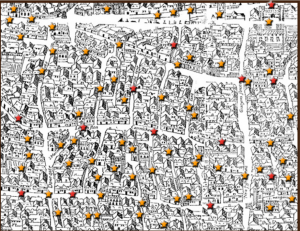The document, Harriett Lees + Family was a memoir about a thirty year old women, Harriett Lees who was born on February 11th, 1811 in Woodford cum Membris, the country of Northhampton. She was a wife to thirteenth brother, William Lees, and a mother of two sons. Her marriage on June 4th, 1838 William Lees sparked and advanced her religious beliefs. She was became a member of the Brn’s Church where she found herself attending regularly. She was extremely religious and believed God “will not lay upon us more than we can bear”. She often quoted the bible throughout her memoir, which was very compelling. Two instance in her life where she demonstrated her spirituality and religious beliefs was when both her brother and sister passed. She was distraught and found that attending chapel was the best way to cope with her sadness. When others recommended staying home instead of attending chapel due to her poor health, she would respond ‘”I am able to go, the Lord blesses any soul more than the effort injures my feeble frame'”. She would attend chapel as long as she had strength. Harriett Lees’s “health was delicate” and “she was often subject to bad colds attended by severe cough” (5). She struggled with her health through her pilgrimage and two pregnancies, which ultimately led to death.
After transcribing and reading the fascinating text, Harriett Lees + Family, Hailey and I became very interested on the research question, what is the typical language of a married sister in the Moravian church? When responding to our research question, the use of Voyant was useful and helpful. This tool highlighted the most frequent words and phrases in our text, making it easy to see what was of importance. It offered us a way to look deeply into the text and observe what hardships she faced and how she overcame them. Voyant is an efficient and more pleasing way to gain the important information needed from a long text. For example, some words cirrus highlighted were sister, savior, time, strength, church and mourning. With the most frequent words displayed, I was able to make some accusations about the text. For example, with seeing the word strength and time, I was able to understand that Harriett’s health was at stake. I was also able to sense that their was tragic events and her emotions were scattered with seeing the frequent words mourning. And at last, seeing the common words church, God, and Savior demonstrated that Harriett Lees was extremely religious. Voyant is helpful in many other ways as well. For example, Voyant showed me that the Harriett Lees memoir Hailey and I transcribed is 2,099 words and includes 731 unique words, which I found slightly surprisingly.
Voyant was also useful because it featured the key and distinctive terms in the memoir. Hailey and I used the Memoir of Br John Willey to get accurate distinctive words from the Harriet Lee’s Memoir. The words that were displayed include tho, fit, partner, oh, and lee. The one word that is most relevant and of importance to answering our question we proposed is “partner”. The distinctive word “partner” was used when discussing Harriet Lee’s marriage with her husband. This was significant in throughout the memoir when William supported Harriett through her sickness and births of her two children. There marriage was strong and they shared a true love with one another. Voyant helped me make connections and understand the memoir a lot better than I had before.
One of Whitley’s methods I used throughout this process is visualization. Visualizations sparked new ideas and questions about what I was transcribing, which was very fun! Three specific ways I used spatial reading on Voyant was through the tools of cirrus, collocates graphs, and bubbliness, which is shown below. Bubbliness visualizes and distributes the terms in the text, while collocate graphs represent key words that occur in close proximity. Cirrus is another visualization tool that measures the top frequency words of the text. All three ways are a unique way to analyze text.

![]()

https://voyant-tools.org/?corpus=df109f8e08232a569e886362ca2e885b
My personal favorite method I used throughout this process on Voyant is spatial reading. Spatial reading is the “idea that reading and understanding large amounts of texts can be overcome if the information is transformed into a more spatial manner/ representation because it can be explored by our visionary processes (Whitley 194). I find spatial reading very effective and more enjoyable than sequential reading. Another technique I used in this process from Whitley’s reading is distant reading. Distant reading is “the act of stepping back from the text you’re reading and study the “broad patterns that emerge when you consider a wide swath of texts”(188). I started looking at the most frequent words and their contexts, which provided me a lot of important information.
Paige Whitney is a sophomore at Bucknell University. She is from Darien, CT. She is undeclared, but has interests in psychology, management, and economics.



